s-Sequence-Covering Mappings on Metric Spaces
Xiangeng Zhouand Li Liu
Department of Mathematics,Ningde Normal University,Ningde 352100,China.
Abstract.In this paper,we introduce and study s-sequence-covering mappings and 1-s-sequence-covering mappings,obtain some characterizations of s-sequence-covering and compact images of metric spaces,and prove that every s-sequence-covering and compact mapping in first-countable spaces is a 1-s-sequence-covering mapping.
Key words:Statistical convergence,s-sequence-covering mappings,1-s-sequence-covering mappings,compact mappings.
1 Introduction
Statistical convergence as a generalization of the usual notion of convergence was introduced by H.Fast[1]and H.Steinhaus[2].There is not doubt that the study of statistical convergence and its various generalizations has become an active research area[3–8].The original notion of statistical convergence was introduced for the real space R.Generally speaking,this notion was extended in two directions.One is to discuss statistical convergence in more general spaces,for example,locally convex spaces[9],Banach spaces with the weak topologies[6,10,11],and topological spaces[5,7,8].The other is to consider generalized notions defined by various limit processes,for example,A-statistical convergence[12],lacunary statistical convergence[13],andλ-statistical convergence[14].Perhaps,a most general notion of statistical convergence is ideal(or filter)convergence[15,16].On the other hand,to find the internal characterizations of certain images of metric spaces is one of the central questions in general topology.F.Siwiec[17]introduced the concept of sequence-covering mappings.Thereafter,the research in this area has been well developed[18–22].
As we know,sequence-covering mappings,1-sequence-covering mappings and sequentially quotient mappings are one of the most important tools to study certain images of metric spaces[19].Recently,V.Renukadevi and B.Prakash defined two new sequencecovering mappings about statistical convergence as follows:Letf:X→Ybe a mapping.The mappingfis said to be astatistically sequence-covering mapping[23],if for a given sequence{yn}n∈Nwithyn→yinY,there exists a sequence{xn}n∈Nwhich statistically converges to a pointx∈f?1(y)and eachxn∈f?1(yn);the mappingfis said to be astatistically sequentially quotient mapping[24],if for a given sequenceyn→yinY,there exists a sequencexk→x∈f?1(y)such that the sequence{f(xk)}k∈Nis statistically dense in{yn}n∈N.They discussed the relationship among sequence-covering mappings,statistically sequence-covering mappings and statistically sequentially quotient mappings,and studied their roles in the images of metric spaces.
Theorem 1.1([24]).Let f:X→Y be a statistically sequentially quotient and boundary-compact map.If the space X is an open and compact-covering image of some metric space,then f is a 1-sequence-covering map.
It is well known that we have the following result for the usual convergence.
Theorem 1.2([22]).The following are equivalent for a topological space X:
(1)X is a sequence-covering and compact image of a metric space.
(2)X is a 1-sequence-covering and compact image of a metric space.
(3)X has a point-star network consisting of point-finite cs-covers.
(4)X has a point-star network consisting of point-finite sn-covers.
We wonder if there are similar results for the case of statistical convergence?For this reason,this paper introduces and discussess-sequence-covering mappings and 1-s-sequence-covering mappings.It is expected thats-sequence-covering mappings and 1-s-sequence-covering mappings shall also play an active role.
2 Preliminaries
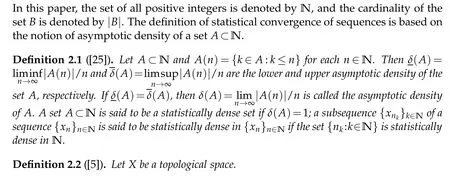


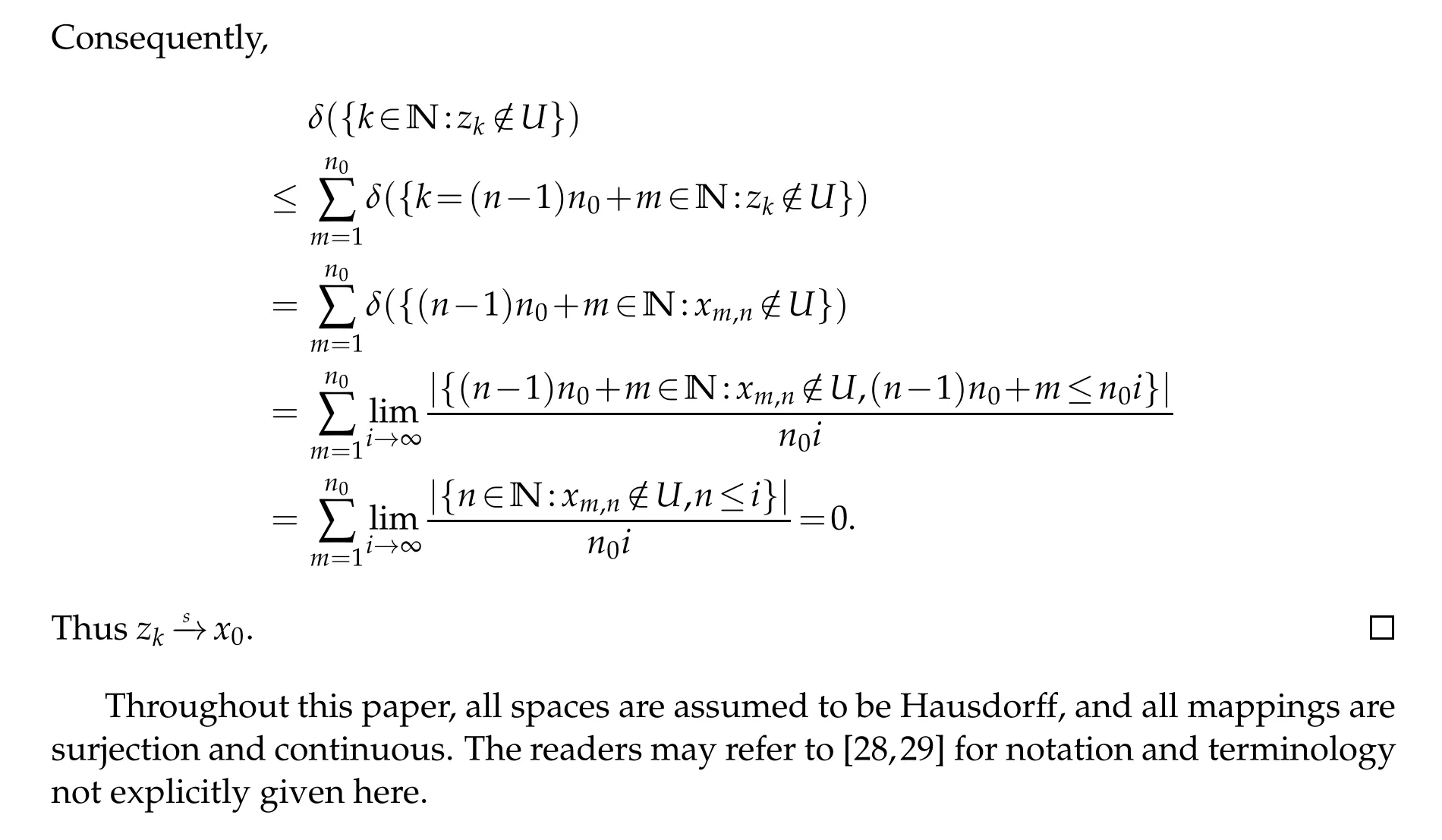
3 s-sequence-covering and compact images of metric spaces

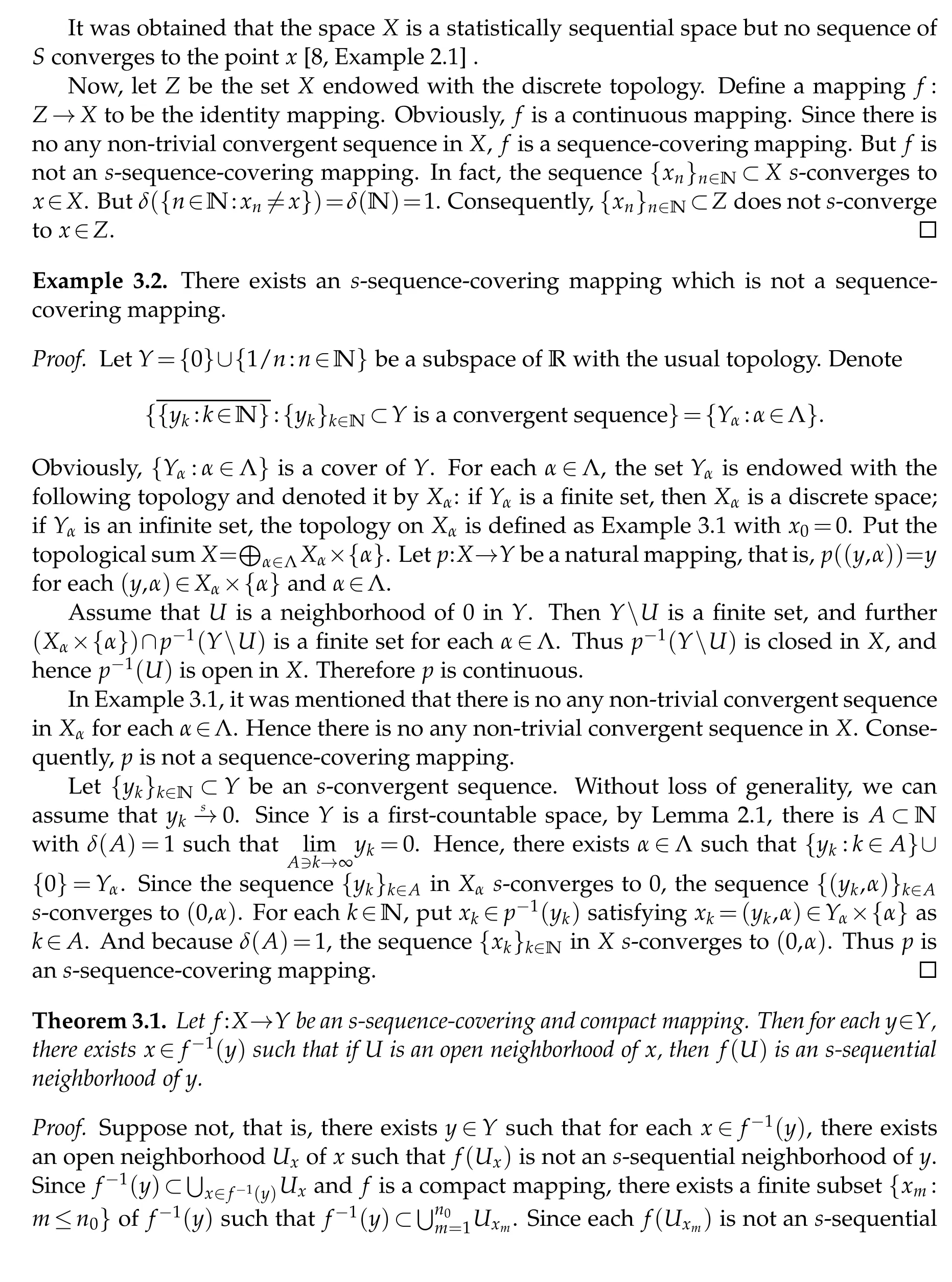
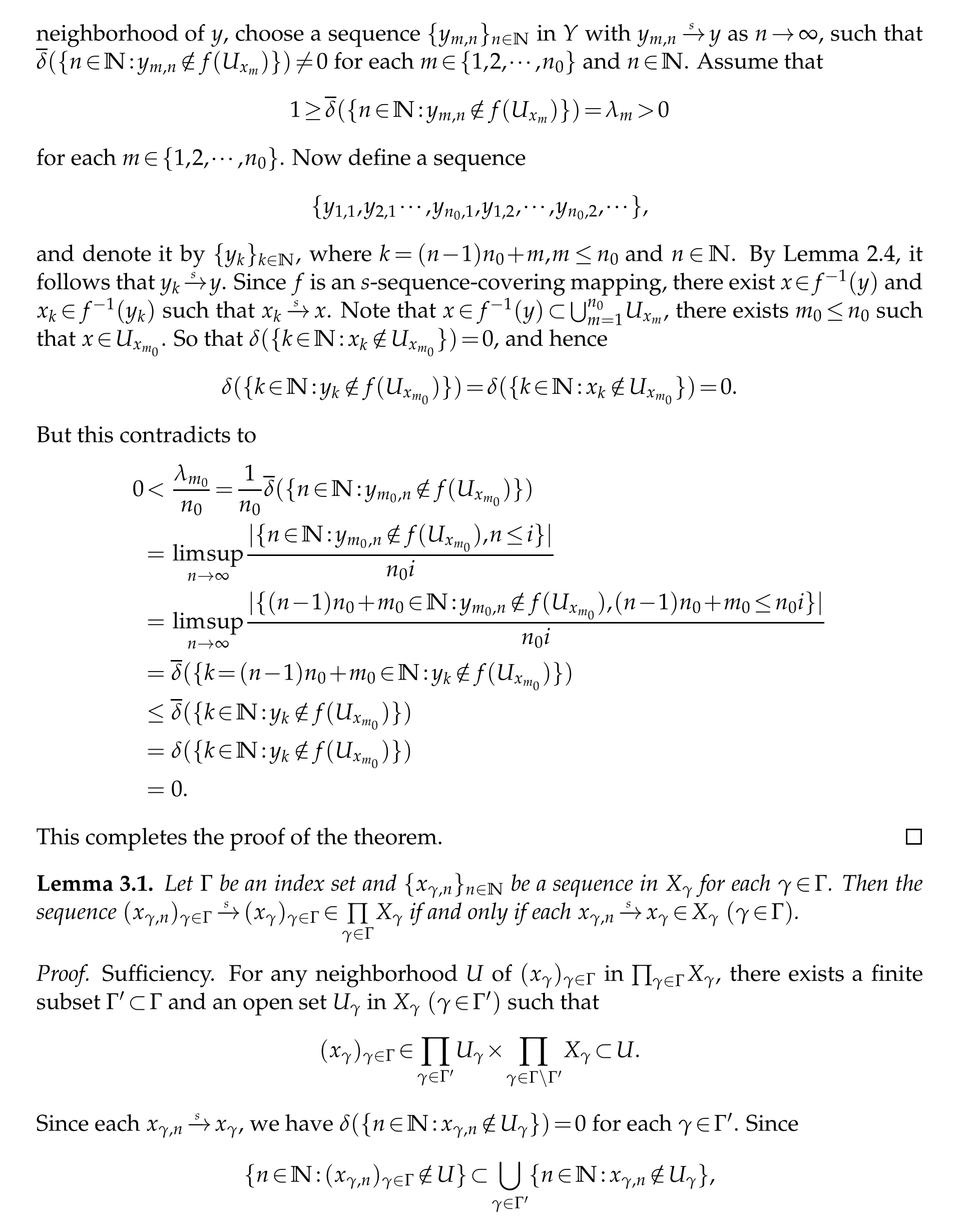
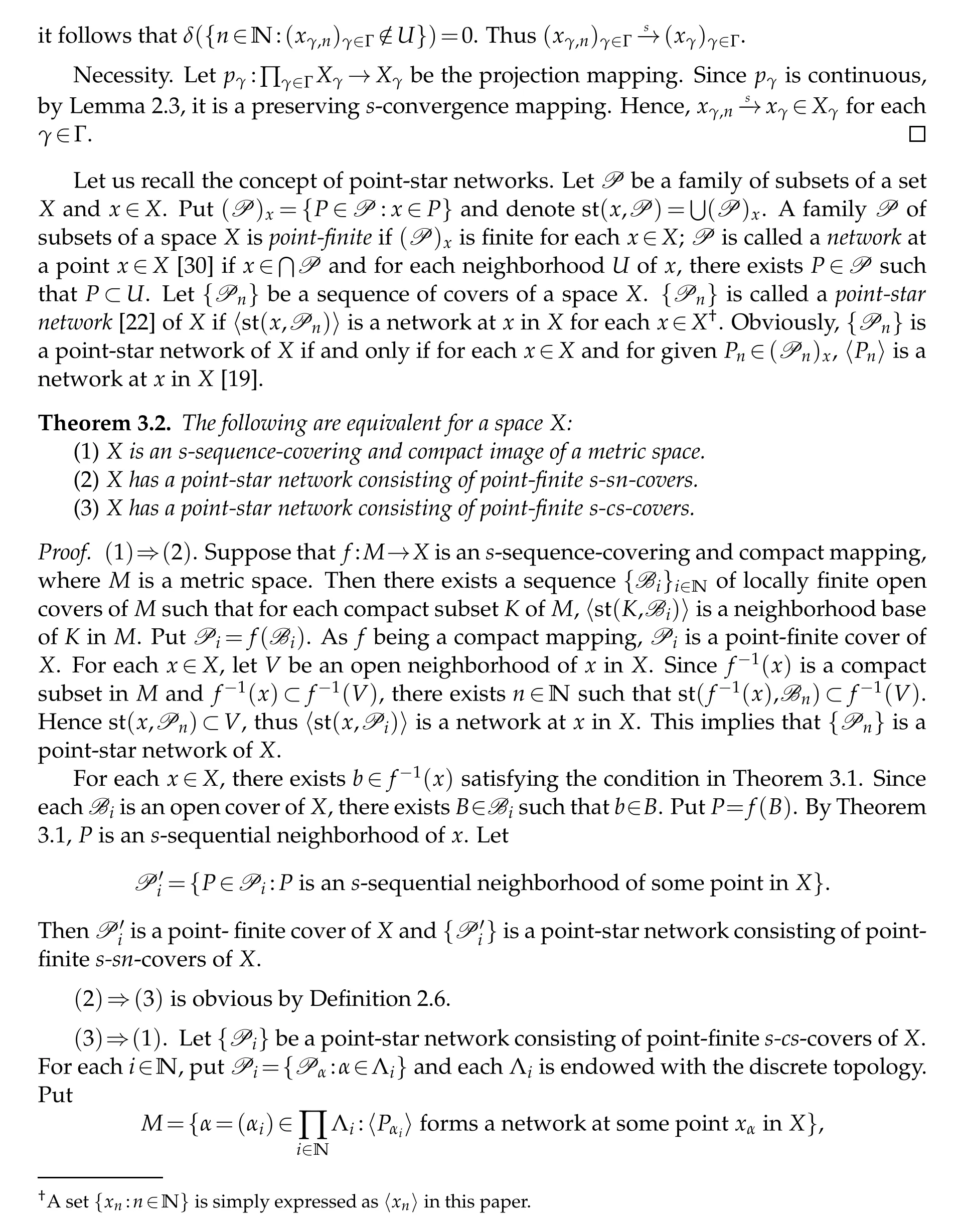
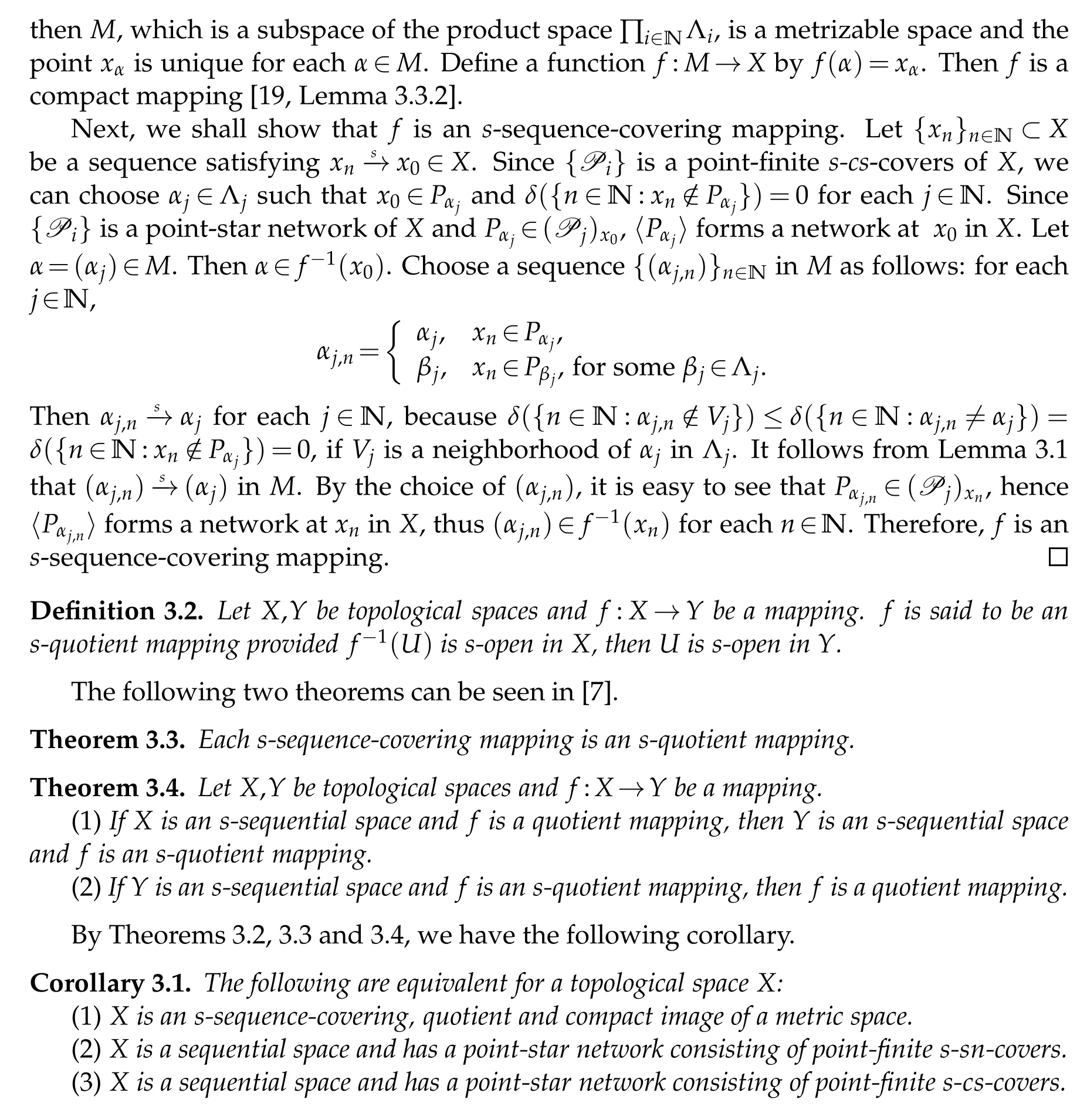
4 1-s-sequence-covering mappings on first-countable spaces
The work of this section is a continuation of the previous section.In this section,we obtain thats-sequence-covering and compact mappings in first-countable spaces are 1-s-sequence-covering mappings.Recall the notion of 1-sequence-covering mappings in topological spaces.A mappingf:X→Yis a1-sequence-covering mappingif for eachy∈Y,there isx∈f?1(y)such that whenever{yn}is a sequence converging toyinYthere is a sequence{xn}converging toxinXwith eachxn∈f?1(yn)[18].
definition 4.1.A mapping f:X→Y is called a 1-s-sequence-covering mapping if for each y∈Y,there is x∈f?1(y)such that whenever{yn}is a sequence statistically converging to y in Y there is a sequence{xn}statistically converging to x in X with each xn∈f?1(yn).
Obviously,iffis a 1-s-sequence-covering mapping,thenfis ans-sequence-covering mapping.Two examples below show that 1-sequence-covering mappings and 1-s-sequencecovering mappings are independent.
Example 4.1.There exists a 1-sequence-covering mapping in a first-countable space which is not ans-sequence-covering mapping.
Proof.Letf:Z→Xbe the mapping in Example 3.2.ThenZis a first-countable space.Example 3.2 showed the mappingfis not ans-sequence-covering mapping.Since there is no any non-trivial convergent sequence inX,fis a 1-sequence-covering mapping.
Example 4.2.There exists a 1-s-sequence-covering mapping which is not a sequencecovering mapping.
Proof.LetX={x}∪{xn:n∈N}be the topological space defined in Example 3.2.Y={0}∪{1/n:n∈N}be a subspace of R with the usual topology.define a mappingf:X→Ybyf(x)=0 andf(xn)=1/nfor eachn∈N.Since there is no any non-trivial convergent sequence inX,fis not a sequence-covering mapping.
For eachy∈Y,without loss of generality,we can assume thaty=0.Takex∈X.If{yn}n∈N?Yis a sequence statistically converging to 0.SinceYis a first-countable space,by Lemma 2.1,there existsA?N withδ(A)=1 and limA?n→∞yn=0.Assume that{yn}n∈N={1/ni}i∈N.Thenf(xni)=1/nifor eachi∈N.Sinceδ(A)=1,{xni}i∈Ncontains a statistically dense subsequence.It follows from Remark 2.1(4)thatxni s?→x.Thusfis a 1-s-sequence-covering mapping.
Lemma 4.1.Let f:X→Y be a 1-s-sequence-covering mapping.Then for each y∈Y,there exists x∈f?1(y)such that whenever U is an open neighborhood of x in X,f(U)is an s-sequential neighborhood of y in Y.
Proof.Lety∈Y.Sincefis a 1-s-sequence-covering,there isx∈f?1(y)satisfying the condition in definition 4.1.LetUbe an open neighborhood ofxinXand{yn}be a sequence statistically converging toyinY.There is a sequence{xn}statistically converging toxinXwith eachxn∈f?1(yn).Henceδ({n∈N:xnU})=0,and furtherδ({n∈N:ynf(U)})≤δ({n∈N:xnU})=0.Therefore,f(U)is ans-sequential neighborhood ofyinY.
Lemma 4.2.Let f:X→Y be a mapping and{Bn}n∈Nbe a decreasing network at some point x in X.If{yi}i∈Nis a sequence in Y statistically converging to f(x)with each δ({i∈ N:yif(Bn)})=0,then there is a sequence{xi}i∈Nstatistically converging to x in X with each xi∈f?1(yi).Proof.Let{yi}i∈Nbe a sequence inYstatistically converging tof(x)andδ({i∈N:yif(Bn)})=0 for eachn∈N.Note that eachf(Bn)?f(Bn+1).For eachi∈N,we can pick

For eachn∈N,ifxiBn,thenyif(Bn).Otherwise,ifyi∈f(Bn),then there existsk≥nsuch thatyi∈f(Bk)f(Bk+1),thusxi∈Bk?Bn,a contradiction;ifyif(Bn),thenf?1(yi)∩Bn=?,hencexiBn.Hence,by the choosing ofxi,it follows thatxiBnif and only ifyif(Bn)for eachn∈N.Thus,xis?→x.In fact,for each open neighborhoodUofx,there existsn0∈N such thatx∈Bn0?U.Therefore,{i∈N:xiU}?{i∈N:xiBn0}={i∈N:yif(Bn0)},henceδ({i∈N:xiU})=0,and further{xi}i∈Nstatistically converges toxinXwith eachxi∈f?1(yi).
Corollary 4.1.Let f:X→Y be a mapping and{Bn}n∈Nbe a decreasing network at some point x in X.If{yi}i∈Nis a sequence in Y statistically converging to f(x)and f(Bn)is an s-sequential neighborhood of f(x)in Y for each n∈N.Then there is a sequence{xi}i∈Nstatistically converging to x in X with each xi∈f?1(yi).
Theorem 4.1.Let f:X→Y be an s-sequence-cover and compact mapping.If X is a first-countable space,then f is a 1-s-sequence-cover mapping.
Proof.By Theorem3.1,it follows that for eachy∈Y,there existsx∈f?1(y)such that ifUis an open neighborhood ofx,f(U)is ans-sequential neighborhood ofy.Let〈Bn〉be a decreasing open neighborhood base atxinX.Thenf(Bn)is ans-sequential neighborhood off(x)inYfor eachn∈ N.By Corollary 4.1,if{yi}i∈Nis a sequence inYstatistically converging toy,there is a sequence{xi}i∈Nstatistically converging toxinXwith eachxi∈f?1(yi).Therefore,fis a 1-s-sequence-cover mapping.
By Theorems 3.2 and 4.1,it is easy to obtain the following corollary.
Corollary 4.2.The following are equivalent for a topological space X:
(1)X is a 1-s-sequence-covering and compact image of a metric space.
(2)X is an s-sequence-covering and compact image of a metric space.
(3)X has a point-star network consisting of point-finite s-sn-covers.
(4)X has a point-star network consisting of point-finite s-cs-covers.
Acknowledgments
Our gratitude goes to Professor Shou Lin for his friendly encouragement and inspiring suggestions.This research is supported by the Natural Science Foundation of Fujian Province(Grant No.2020J01428)and Ningde Normal University(Grant No.2019ZDK11).
 Journal of Mathematical Study2022年1期
Journal of Mathematical Study2022年1期
- Journal of Mathematical Study的其它文章
- A Kind of Integral Representation on Complex Manifold
- Repdigits Base b as Difference of Two Fibonacci Numbers
- Gradient Bounds for Almost Complex Special Lagrangian Equation with Supercritical Phase
- Zeros of Primitive Characters
- Data Recovery from Cauchy Measurements in Transient Heat Transfer
- On a Coupled Cahn–Hilliard System for Copolymer/Homopolymer Mixtures
